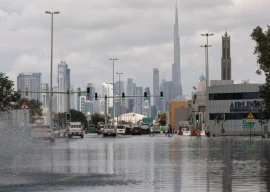
So much water is lost around the world in leaky pipes that it would be cheaper to just give people five litres of drinking water in cans each day. The Italians would need seven litres, though, because they need to boil pasta.
The wry humour of urban development advisor, Nicholas You, barely masks subterranean frustration. He wants us to stop and think about something as dry as water and sewage.
To put this loss in perspective, Karachi loses more than one-third, or 35%, of its water to leaks, estimates the water board. Singapore, at the other end of the spectrum, loses less than 5% of its water. How did the island city state, which at one point imported all its water from neighbouring Malaysia, manage this feat? Can Karachi take a few lessons from the smart city state?
Singapore’s water (re)cycle
For starters, Singapore rigorously replaced its pipes, bringing down the number of leaks from over 18,000 to 4,500 in ten years. Now, the pipes are fitted with technology that detects leaks by noise.
Singapore, however, has good reason to be smart. The island’s 99-year agreement with Malaysia on water expires in 2061, and it is racing ahead to become self-sufficient. At present, nearly 40% of its total supply comes from rainwater. Every drop is collected in a 7,000-km network of drains, canals, rivers, storm-water collection ponds and reservoirs.
The island’s responsibility does not stop there though. It may make you squirm, but one-third of the Singapore’s water demand is met by the cleverly named NEWater: recycled sewage that is used by factories, and is so clean, after ultraviolet and advanced membrane treatment, that you can drink it.
The philosophy of recycling is so strong that it is almost as if Singapore ‘rents’ water out to its residents, who use it and return it.
“What is truly amazing is that [a water-stressed state like] Singapore will have an excess of [93m“ per capita per year] of water,” says You.
Dumping sewage into the sea
Karachi generates 472 mgd of sewage but just treats 55 mgd, or 11%, of it. The bulk of the sewage is dumped raw into the sea after travelling through a complicated pipe network that is 5,670km long.
“The three sewage treatment plants are outdated. We have to replace them now,” says Zaheer Abbas, chief engineer for the sewage treatment and water filtration plants.
“The treatment plants were built in the 1960s and these facilities normally don’t have a life of more than 15 to 20 years,” he adds.
An ambitious plan, however, hopes to recycle wastewater for factories. The project was conceived a few years ago, but its cost has since doubled to Rs13 billion.
It also doesn’t help for Karachi to be situated right at the end of the River Indus, which means that a large part of used water from other cities is reaching Karachi’s taps.
The contamination is so bad that the water board admits it needs to over-chlorinate because the source, Keenjhar Lake, is heavily contaminated.
Desperate for drops
Nicholas You says that food and energy supplies aren’t finite, but fresh water supplies are.
No where is that more evident than in Karachi, which is piping in water from sources farther away than ever.
“Almost all major cities in the world in the 1950s got their water locally,” You said, citing the example of Barcelona that used groundwater six decades ago; the water travelled zero kilometres to reach taps at home. In the year 2000, the Spanish city transports water from over 100 km away.
Karachi currently gets its water from 150 km away and is largely dependent on external sources: Indus River, Haleji lake and Hub dam among others. The desperate water board just announced it was going to drill 500 feet down at the century old Dumlottee wells to try and get a fresh supply.
Even Karachi’s newly sanctioned K-IV project is going to bring water from hundreds of kilometers away. That is a problem because migrating water from so far away costs money, and consumes energy – resources that the water board has little of. The entity is unable to pay its bills and Karachi’s electricity supplier frequently cuts off power at pumping stations. It is only when the governor, or other high authorities intervene that KESC switches the power back on.
Nicholas You was presenting the information to 31 urbanists who had gathered in Bellagio over July 30 to August 4 for a summit organised by the Urban Land Institute and Citistates Group.
Pay-per-sip
Charging for water to control demand
Water is treated like any other utility in Singapore: there are water meters checking consumption, and the more you use, the more you pay. So, for example, if you use under 40m“, you pay S$1.17 per m“. If you use more than 40m“, the price goes up to S$1.4. Still, the average bill for a small household is fairly affordable, at about S$30 a month. If you steal water you can face up to S$50,000 in fines and three years in jail.
The population, therefore, has become water-conscious and the government has won the battle that is being lost in so many other countries. Household water consumption has gone down from 165 litres per person per day in 2003 to 154 litres a day last year.
Karachi Water and Sewerage Board’s problem is that it charges too little for water and sewage and only 1.4 million customers are on its list in a city of 18 million. Consumers are also not charged for how much they use, since there are no water meters attached to their homes, leading to waste. The billing, instead, is pegged to plot size. A 500-square-yard single storey house, for example, pays Rs6,200 a year for its water supply, no matter how much it uses, and Rs768 for sewage services.
Competing jurisdictions
To Many Cooks Spoil The Water
Urban development advisor Nicholas You explains the plague of competing jurisdictions: In an ordinary city, one authority exploits the water, one transports it to a reservoir, one sends it to a bulk supplier, who will purify it and send it to a municipal authority. Add to that three entities dealing with wastewater and you have up to seven separate agencies dealing with water. In Singapore, however, supply, demand and treatment are all managed by one agency – the Public Utilities Board (PUB).
“I’m not saying it’s a model you can repeat all over the world but we have to start thinking about it,” urges You.
In Karachi, the water board handles the supply and sewage, but it has to contend with the Indus River System Authority and unofficial agents that interfere with the supply: they range from the army-run housing authority with its failed desalination plant to the water tanker mafia that steals from hydrants, to households that use supplies brought on donkey carts and boreholes.
Published in The Express Tribune, August 23rd, 2012.
COMMENTS (4)
Comments are moderated and generally will be posted if they are on-topic and not abusive.
For more information, please see our Comments FAQ




































1713853507-0/MalalaHilary-(2)1713853507-0-270x192.webp)







but there is a difference in Pakistan and Singapore....!
In Karachi in electricity we have higest line losses ( mostly due to stealing of electricity) and we have water losses for similar reasons. What Karachi should seriously consider is water harvesting (conserving water) and the government should give incentives for water harvesting. Here the problem is the government wants to over tax the few who pay taxes balance are in power corridors or on streets
Very Informative Hope our concern authorities will take lessons from Singapore !